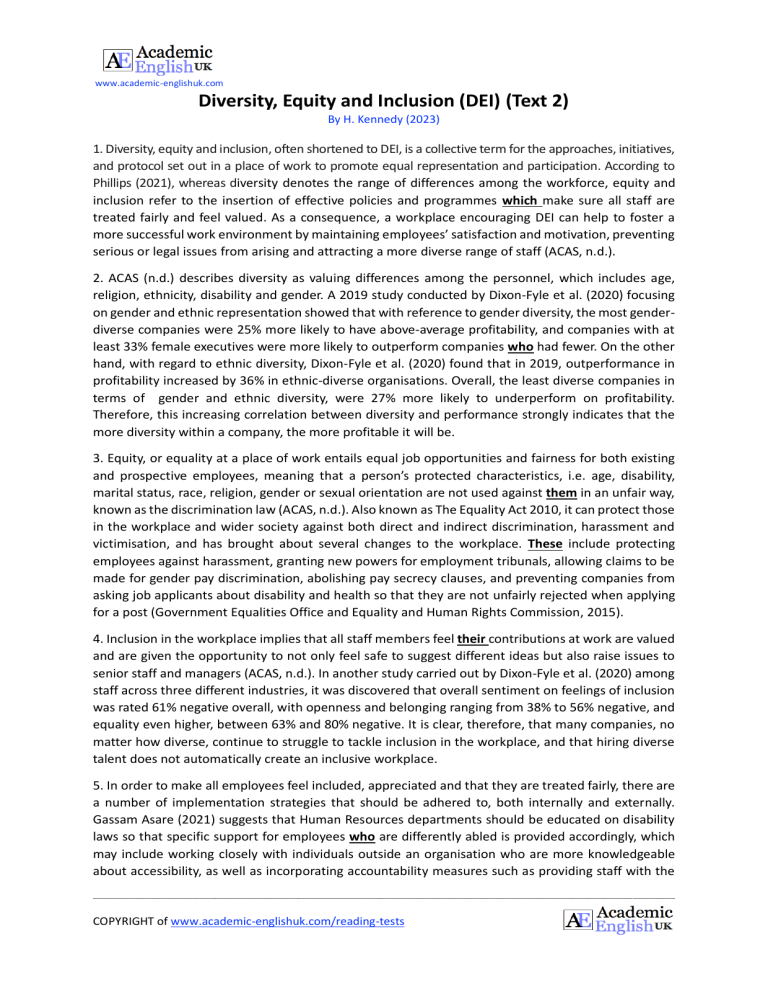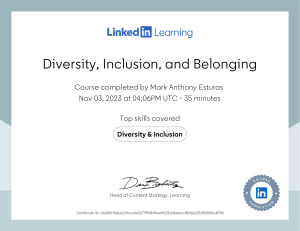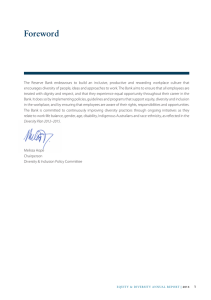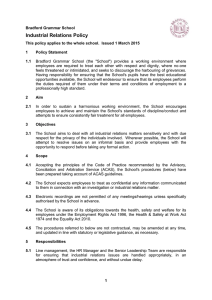
www.academic-englishuk.com Diversity, Equity and Inclusion (DEI) (Text 2) By H. Kennedy (2023) 1. Diversity, equity and inclusion, often shortened to DEI, is a collective term for the approaches, initiatives, and protocol set out in a place of work to promote equal representation and participation. According to Phillips (2021), whereas diversity denotes the range of differences among the workforce, equity and inclusion refer to the insertion of effective policies and programmes which make sure all staff are treated fairly and feel valued. As a consequence, a workplace encouraging DEI can help to foster a more successful work environment by maintaining employees’ satisfaction and motivation, preventing serious or legal issues from arising and attracting a more diverse range of staff (ACAS, n.d.). 2. ACAS (n.d.) describes diversity as valuing differences among the personnel, which includes age, religion, ethnicity, disability and gender. A 2019 study conducted by Dixon-Fyle et al. (2020) focusing on gender and ethnic representation showed that with reference to gender diversity, the most genderdiverse companies were 25% more likely to have above-average profitability, and companies with at least 33% female executives were more likely to outperform companies who had fewer. On the other hand, with regard to ethnic diversity, Dixon-Fyle et al. (2020) found that in 2019, outperformance in profitability increased by 36% in ethnic-diverse organisations. Overall, the least diverse companies in terms of gender and ethnic diversity, were 27% more likely to underperform on profitability. Therefore, this increasing correlation between diversity and performance strongly indicates that the more diversity within a company, the more profitable it will be. 3. Equity, or equality at a place of work entails equal job opportunities and fairness for both existing and prospective employees, meaning that a person’s protected characteristics, i.e. age, disability, marital status, race, religion, gender or sexual orientation are not used against them in an unfair way, known as the discrimination law (ACAS, n.d.). Also known as The Equality Act 2010, it can protect those in the workplace and wider society against both direct and indirect discrimination, harassment and victimisation, and has brought about several changes to the workplace. These include protecting employees against harassment, granting new powers for employment tribunals, allowing claims to be made for gender pay discrimination, abolishing pay secrecy clauses, and preventing companies from asking job applicants about disability and health so that they are not unfairly rejected when applying for a post (Government Equalities Office and Equality and Human Rights Commission, 2015). 4. Inclusion in the workplace implies that all staff members feel their contributions at work are valued and are given the opportunity to not only feel safe to suggest different ideas but also raise issues to senior staff and managers (ACAS, n.d.). In another study carried out by Dixon-Fyle et al. (2020) among staff across three different industries, it was discovered that overall sentiment on feelings of inclusion was rated 61% negative overall, with openness and belonging ranging from 38% to 56% negative, and equality even higher, between 63% and 80% negative. It is clear, therefore, that many companies, no matter how diverse, continue to struggle to tackle inclusion in the workplace, and that hiring diverse talent does not automatically create an inclusive workplace. 5. In order to make all employees feel included, appreciated and that they are treated fairly, there are a number of implementation strategies that should be adhered to, both internally and externally. Gassam Asare (2021) suggests that Human Resources departments should be educated on disability laws so that specific support for employees who are differently abled is provided accordingly, which may include working closely with individuals outside an organisation who are more knowledgeable about accessibility, as well as incorporating accountability measures such as providing staff with the _____________________________________________________________________________________________________________________________________________________________________________________ COPYRIGHT of www.academic-englishuk.com/reading-tests www.academic-englishuk.com opportunity to rate the company’s leadership, allowing employees to report exclusionary behaviour anonymously, and having a clear procedure for how it is dealt with. Dixon-Fyle et al. (2020) also recommend drawing up workplace policies that include training and development for all staff so that they all understand the policy, what needs to happen to make it work in practice, and how to best monitor and measure it. Finally, ACAS (n.d.) propose a systematic, business-lead approach to DEI which includes increased diverse representation in leadership and critical roles, the promotion of openness throughout the workforce and confronting bias directly. 6. Although some progress towards creating more diverse, equitable and inclusive workplaces has been made in some institutions, the majority have made very little, or none at all. A data comparison between companies based in the USA and the UK and those around the world revealed that in the former, representation of women and ethnic minorities on executive teams in 2019 was at 20% and 13% respectively, whereas gender and ethnic diversity in the latter stood at 15% and 14% (Dixon-Fyle et al., 2020). Hence, it is clear that more effective DEI practices need to be implemented across the board and the globe. Reference list ACAS, (n.d.). Improving equality, diversity and inclusion in your workplace [online]. Available at: https://www.acas.org.uk/improving-equality-diversity-and-inclusion [Viewed 11.01.2023]. Dixon-Fyle, S., Dolan, K., Hunt, V., and Prince, S., (2020). Diversity wins: How inclusion matters [online]. Available at: https://www.mckinsey.com/featured-insights/diversity-and-inclusion/diversity-wins-howinclusion-matters [Viewed 10.01.2023]. Gassam Asare, J., (2021). 4 DEI Practices Your Company Should Adopt In 2022 [online]. Available at: https://www.forbes.com/sites/janicegassam/2021/12/29/4-dei-practices-your-company-should-adopt-in2022/?sh=3bc5e09b41d5 [Viewed 11.01.2023]. Government Equalities Office and Equality and Human Rights Commission, (2015). Equality Act 2010: guidance [online]. Available at: https://www.gov.uk/guidance/equality-act-2010-guidance [Viewed 11.01.2023]. Phillips, N., (2021). Exploring DEI Trends and Initiatives for 2022 [online]. Available at: https://trainingindustry.com/articles/diversity-equity-and-inclusion/exploring-dei-trends-and-initiatives-for2022/ [Viewed 10.01.2023]. _____________________________________________________________________________________________________________________________________________________________________________________ COPYRIGHT of www.academic-englishuk.com/reading-tests




